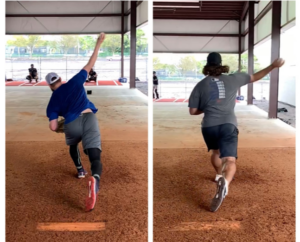
Random Thoughts on Sports Performance Training – Installment 36
This edition random thoughts from around the field of health and human performance is long overdue. Fortunately, more of the world is online more than ever, so at least it’ll have a good audience now!
1. Physical maturity and training experience impact pitching stress.
File this one under the “duh” category, but it’s good to have a study supporting the concept nonetheless. In this study, Nicholson et al found that while pitching velocity was weakly related to shoulder distraction force, this relationship was only observed in high school (and not college) pitchers. The researchers noted, “These findings suggest that older pitchers may attenuate shoulder forces with increased pitch velocity due to physical maturity or increased pitching mechanical skill in comparison with younger pitchers.”
Here’s the position (ball release) to which they’re referring:
I’ve seen research in the past that reported shoulder distraction forces were 1.5 times body weight at ball release, but those numbers never made sense to me in light of the kinetic chain concept. Wouldn’t a pitcher with better front hip pull-back, core control, thoracic spine mobility, scapular control, and posterior cuff strength have a better chance of dissipating these forces over a longer deceleration arc than someone who wasn’t as physically prepared? And, wouldn’t different release points (as shown above) relate to different stresses? This study demonstrates that being physically prepared and mature goes a long way in reducing one potential injury mechanism in throwers.
2. “You can’t separate biomechanics from metabolism.”
I remembered this quote from Charlie Weingroff years ago when I recently heard White Sox infielder Yoan Moncada discussing how he hasn’t felt like himself ever since he came back to playing after having COVID-19. Obviously, this is a more extreme perspective, as we know some cases lead to myocarditis and other challenging complications. It’s certainly not out of left field, though. Just think about it:
Your joints often ache when you have the flu.
Many people get neck pain when they’re stressed.
And, as Charlie observed in that same presentation, the higher your free cortisol, the poorer neurogenesis is.
I don’t think we have to just consider these challenges only when someone is sick or under crazy stress. Rather, we have to appreciate that optimizing our metabolic environment – whether it’s building a robust aerobic system or eating well and exercising frequently to improve insulin sensitivity – likely has an impact on how our musculoskeletal and fascial systems feel and perform. And, the nice thing about a lot of these initiatives is that they aren’t hard to chase: you can build your aerobic system with some low-key cardio or even mobility circuits.
3. Vary surfaces with plyometric activities.
The latest Journal of Strength and Conditioning Research featured a very intriguing study that compared outcomes of a plyometric program on grass-only versus one that was matched for volume, but spread over six different surfaces: grass, land-dirt, sand, wood, gym mat, and tartan-track. The group that performed the multi-surface program outperformed the grass-only group at post-testing even though the testing took place on grass (which means it was a better program to the point that it also outperformed pure specificity over eight weeks, a relatively short intervention).
This is great because training should always be about providing a rich proprioceptive environment for athletes while still providing specificity. The surfaces were stable and ranged in their ability to challenge the stretch-shortening cycle (i.e., it’s harder to “turn over” a jump quickly in sand than it is on a track surface).
Intuitively, it makes sense: give athletes variability across similar exercises and you get better adaptation. And, you could even make the argument that it likely reduces the potential for overuse injuries. Just imagine if they’d also rotated types of footwear: barefoot, minimalist sneakers, cross-trainers, turf shoes, cleats, etc.
Suffice it to say that I’ll be leveraging this knowledge heavily at our new Cressey Sports Performance – Florida facility. We’ve got outdoor turf, indoor turf, grass, and indoor gym flooring – and we could do all three either in shoes or barefoot. There’s eight options right there, and it’s not hard to get access to sand in South Florida!
4. Exercise selection is the most important acute programming variable.
When you’re writing a program, the big rocks to consider are intensity (load), volume, rest, tempo, exercise order, and exercise selection.
You’ll see a lot of debates about whether 4 sets of 6 reps works better than 6 sets of 4 reps, and whether you need to do one set or three sets to get optimal gains. People may argue about whether you have to train above 90% of 1RM to get strength gains. And, internet arguments are fierce over tempo prescriptions and whether you should squat before you deadlift, or vice versa.
You know what doesn’t get debated? The simple question, “Does an exercise hurt?”
This is why exercise selection will always be the most important acute programming variable to consider. If it causes pain, all the other variables don’t matter, because it’s a harmful training stimulus. This is why it’s tremendously important for coaches to not only understand progressions, but also regressions and “lateral moves.”
Squatting hurts your hips? Let’s try a reverse lunge with a front squat grip.
Deadlifting isn’t agreeing with your low back? Let’s try a hip thrust instead.
Bench press is making your shoulder cranky? Let’s pivot to a landmine press instead.
These quick and easy adjustments can absolutely save a program – and make all the other programming variable important actually matter. This is a big reason why I included an Exercise Modifications Library in The High Performance Handbook; they enable an individual to keep the core benefits of the program intact even if they have to modify a few exercises along the way.





